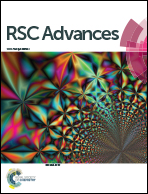Rapid transformation of transparent conducting films into superhydrophobic conductive films†
Abstract
A smart multifunctional surface of conductive plastics with a superhydrophobic surface having porous micro- and nano-structures can potentially be very useful in many applications of electrostatic dissipation (ESD), electromagnetic interference (EMI) shielding, and in transparent film heaters with self-cleaning properties. Here, we demonstrate a facile and rapid method for fabricating superhydrophobic conductive films from transparent conductive films with silver nanowires (AgNWs) and single-walled carbon nanotubes (SWCNTs) on polycarbonate (PC). This process involves the swelling of the PC surface in a dispersion of multi-walled CNTs (MWCNTs) in methyl ethyl ketone (MEK), followed by coagulation in isopropyl alcohol (IPA, nonsolvent for PC). During swelling, the AgNWs and SWCNTs migrated into the plastic, and after that, the swollen PC chains were crystallized in IPA. Notably, by adding MWCNTs in MEK, the crystallization of PC chains was accelerated, and the rapid increase in the electrical resistivity of the film was minimized by reducing the formation of microstructures. Crystallization of the AgNW/SWCNT electrode onto PC and the incorporation of MWCNTs during crystallization provided a flexible superhydrophobic heater for use as a self-cleaning surface.



 Please wait while we load your content...
Please wait while we load your content...